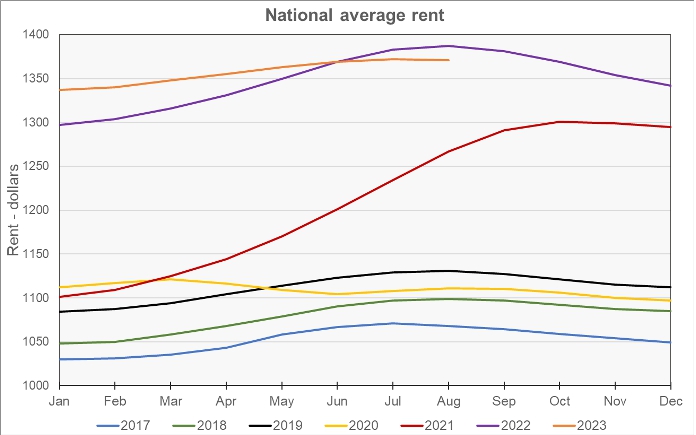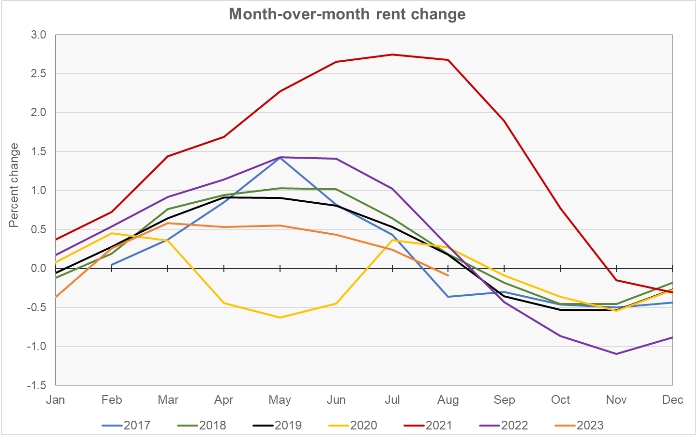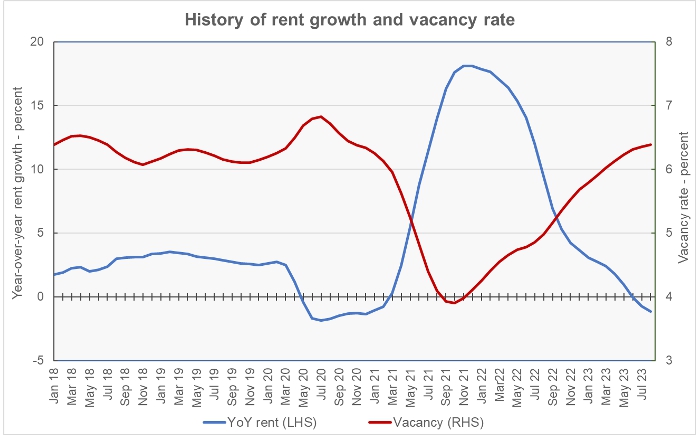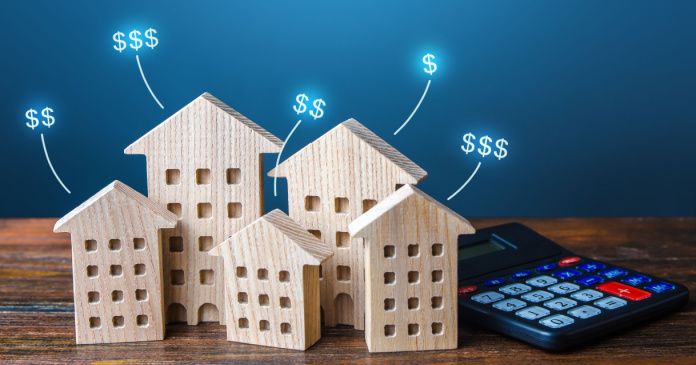The latest rent report from Apartment List shows that the national average monthly rent growth in August was -0.1 percent, the first negative reading since February. Year-over-year rent growth was -1.2 percent. The month-over-month results are the worst for an August except for 2017, the year that Apartment List began collecting data.
Apartment List reported the national average apartment rent was $1,371, down $1 from last month’s figure.
Visualizing the data
The first chart shows the history of the national average rent level since 2017. It is plotted year-by-year so that the annual change pattern is visible. It shows that, for the past two months, rents have been below their levels in the same months last year.

The next chart shows the month-over-month rent growth rate for the Apartment List data set. The chart shows that rent growth this year has followed the pattern of earlier non-shutdown years with rents rising in the first part of the year. However, the rates of rent growth have been lower than is typical. Last month was only the second August in the Apartment List dataset that saw rents fall month-over-month.

The final chart shows the year-over-year rate of rent growth since January 2018 plotted along with the national average apartment vacancy rate.

The chart shows that the current vacancy rate is 6.4 percent, in line with the average from 2108 and 2019. However, the current year-over-year rent growth rate of -1.2 percent is well below the average +2.8 percent rent growth seen in 2018 and 2019, but it is still above the rent declines seen in 2020.
Leaders and trailers
Apartment List provides the underlying data they collected in compiling their report and that data was used to create the tables, below. The tables look at the 50 most populous metropolitan statistical areas defined by the US Census Bureau and identify the top and bottom 10 metros for year-over-year rent growth. The tables provide the average monthly rent in the metro, the metro’s vacancy rate, the annual percentage change in rent (YoY Metro) along with the percentage change from the prior month’s rent level (MoM Metro). They also list the percentage changes in rent for the metro areas compared to the rent levels in February 2020, right before the pandemic struck (Feb 20).
The first table shows the 10 metros with the largest annual rent percentage increases. Many of these metros are centered around midwestern cities.
| Metro | Metro Rent | Vacancy | YoY Metro | MoM Metro | Feb 20 |
| Chicago | $1,456 | 5.5 | 3.3 | (0.03) | 20.0 |
| Kansas City | $1,248 | 8.3 | 3.2 | 0.26 | 23.6 |
| Hartford | $1,546 | 7.9 | 3.0 | 0.26 | 29.7 |
| Milwaukee | $1,133 | 5.5 | 2.6 | (0.04) | 20.9 |
| Louisville | $1,102 | 6.4 | 1.8 | 0.41 | 21.4 |
| Cincinnati | $1,168 | 7.0 | 1.6 | 0.38 | 30.2 |
| Boston | $2,018 | 6.9 | 1.5 | 0.02 | 19.4 |
| Indianapolis | $1,211 | 5.8 | 1.4 | 0.30 | 29.9 |
| St Louis | $1,153 | 6.1 | 1.1 | (0.37) | 20.1 |
| New York | $2,126 | 4.4 | 1.1 | 0.35 | 21.8 |
The next table shows the 10 metros with the smallest annual rent increases.
| Metro | Metro Rent | Vacancy | YoY Metro | MoM Metro | Feb 20 |
| Austin | $1,629 | 6.1 | (5.4) | (0.73) | 22.3 |
| Las Vegas | $1,501 | 4.4 | (5.1) | (0.51) | 29.1 |
| Portland | $1,528 | 6.3 | (4.7) | (0.43) | 14.1 |
| Phoenix | $1,572 | 5.5 | (4.5) | (0.08) | 28.6 |
| San Francisco | $2,102 | 5.6 | (4.4) | (0.43) | (3.6) |
| Seattle | $1,792 | 5.6 | (4.0) | 0.38 | 12.6 |
| Salt Lake City | $1,464 | 5.1 | (3.9) | (0.21) | 26.4 |
| Atlanta | $1,528 | 6.7 | (3.8) | (0.50) | 25.5 |
| Jacksonville | $1,485 | 6.4 | (3.6) | (0.41) | 29.6 |
| Nashville | $1,459 | 7.8 | (3.5) | (0.26) | 23.1 |
In August, 34 of the 50 most populous metros saw their rents decline on a year-over-year basis, matching last month’s figure. In addition, 28 of the metros saw rents decline on a month-over-month basis. San Francisco remains the only top-50 metro that still has rents that are below their level in February 2020, immediately before the pandemic.
The average rent in the 10 metros with the highest rent growth is $1,416 per month, while the average rent charged in the 10 lowest rent growth metros is 13 percent higher at $1,606 per month.
The average vacancy rate for the high rent growth metros is 6.4 percent compared to 6.0 percent for the low rent growth rate metros. The average rent growth since February 2020, before COVID struck, is 23.7 percent for the high rent growth metros versus 20.8 percent for the others.
The complete Apartment List report covers many more metros. It also provides readers with the opportunity to download their data sets. The latest report can be found here.













